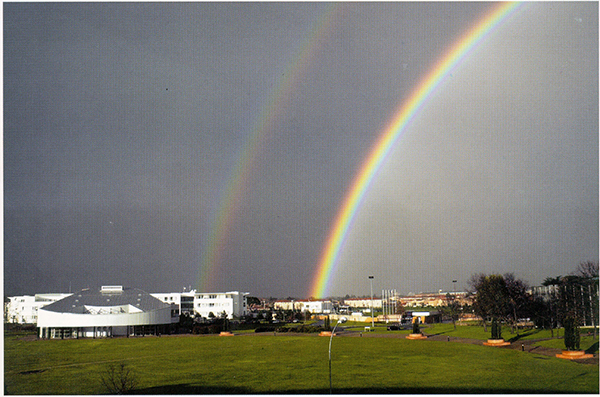
by Lucas Joel Monday, December 21, 2015

A rainbow in Toulouse, France, after a storm. Credit: Jean Ricard
Rainbows — those arches of color that streak across wet skies — are recognizable to almost everyone. Our understanding of rainbows, though, particularly how they form and the diversity of shapes they can take, is still fuzzy.
Previous attempts to classify rainbows suggested that the main reason rainbows form, and the reason they can differ from one another, has mainly to do with the shapes and diameters of the water droplets that create them. However, according to scientists presenting new research last week at the fall meeting of the American Geophysical Union in San Francisco, traditional approaches for classifying rainbows are only telling part of the story.
The new research, presented by Jean Ricard of the Center for the Scientific Study of Optical Atmospheric Phenomena in Toulouse, France, relied on examinations of numerous photographs of different kinds of rainbows — from rainbows including all the colors of the visible light spectrum to monochromatic rainbows that are only red.
“We found that one main factor controlling a rainbow’s nature is the height of the sun above the horizon,” Ricard reported in a press conference at the meeting. Additionally, he and his colleagues found that for some types of rainbows, the size of the water droplets is only a minor factor controlling the overall aspect of the rainbow.
The main portion of a rainbow, called the primary bow, is the brightest part and is typically the only part that is obvious to the naked eye. Above the primary bow is the secondary bow, which displays the same colors of the primary bow but in reverse order. Between the primary and secondary bows lies an area of darkened sky known as the Alexander band. Finally, there are the supernumerary arcs, which are pale pink or green bands that can appear within the primary bow.
To better characterize observed rainbow types, Ricard and his team classified rainbows into 12 types according to three criteria: whether or not certain color bands were visible in the primary bow, the prevalence of the Alexander band, and how visible the supernumerary bands are.
One category is defined by, for instance, all colors being visible while displaying weak Alexander bands and no supernumerary bands. One of the more distinctive new categories consists of predominantly red rainbows that only show hints of yellow and green and that are produced by low-angle sunlight.

A rare red rainbow in the Swiss Alps. Credit: Claudia Hinz
“At sunset, we find that red rainbows are most common,” Ricard said, explaining that “when the sun is right above the horizon, its light has to travel through more atmosphere, which filters out most colors except for those in the red part of spectrum.”
Previously, Ricard said, the angle of the sun had not been considered as a main factor controlling a rainbow’s features. However, differences in appearance among some of the new categories “still depend completely on the shape of the raindrops,” Ricard said, including those containing rainbows in which all colors are visible. Other rainbows, especially those that do not display all colors, are the result of both water droplet shape as well as the height of the sun.
The updated classification system provides a new basis for understanding how rainbows form, Ricard said, which could be useful as a tool for introducing students to the optics of rainbows. There are other potential applications as well, he suggested, including, for example, helping astronomers searching for signs of water in the atmospheres of distant exoplanets.
© 2008-2021. All rights reserved. Any copying, redistribution or retransmission of any of the contents of this service without the expressed written permission of the American Geosciences Institute is expressly prohibited. Click here for all copyright requests.